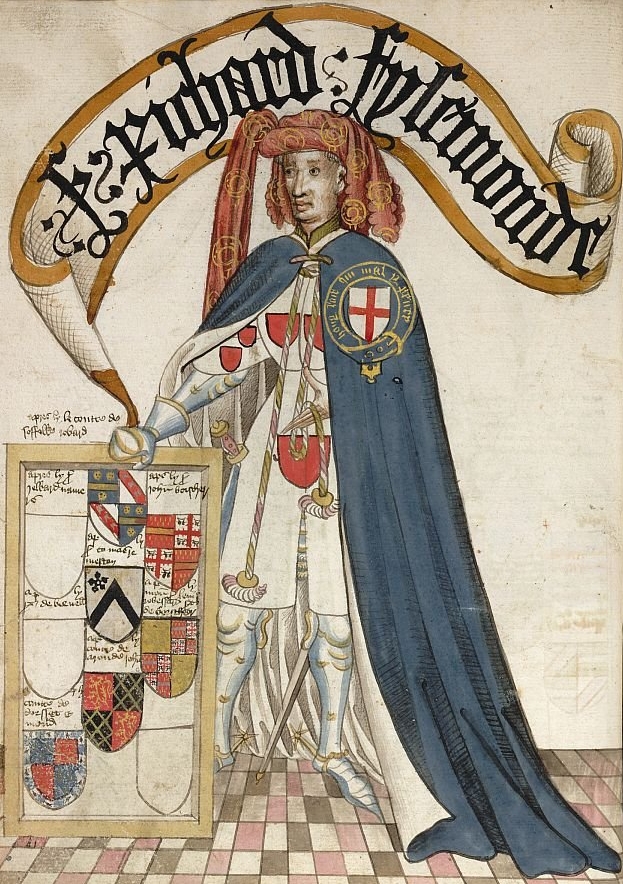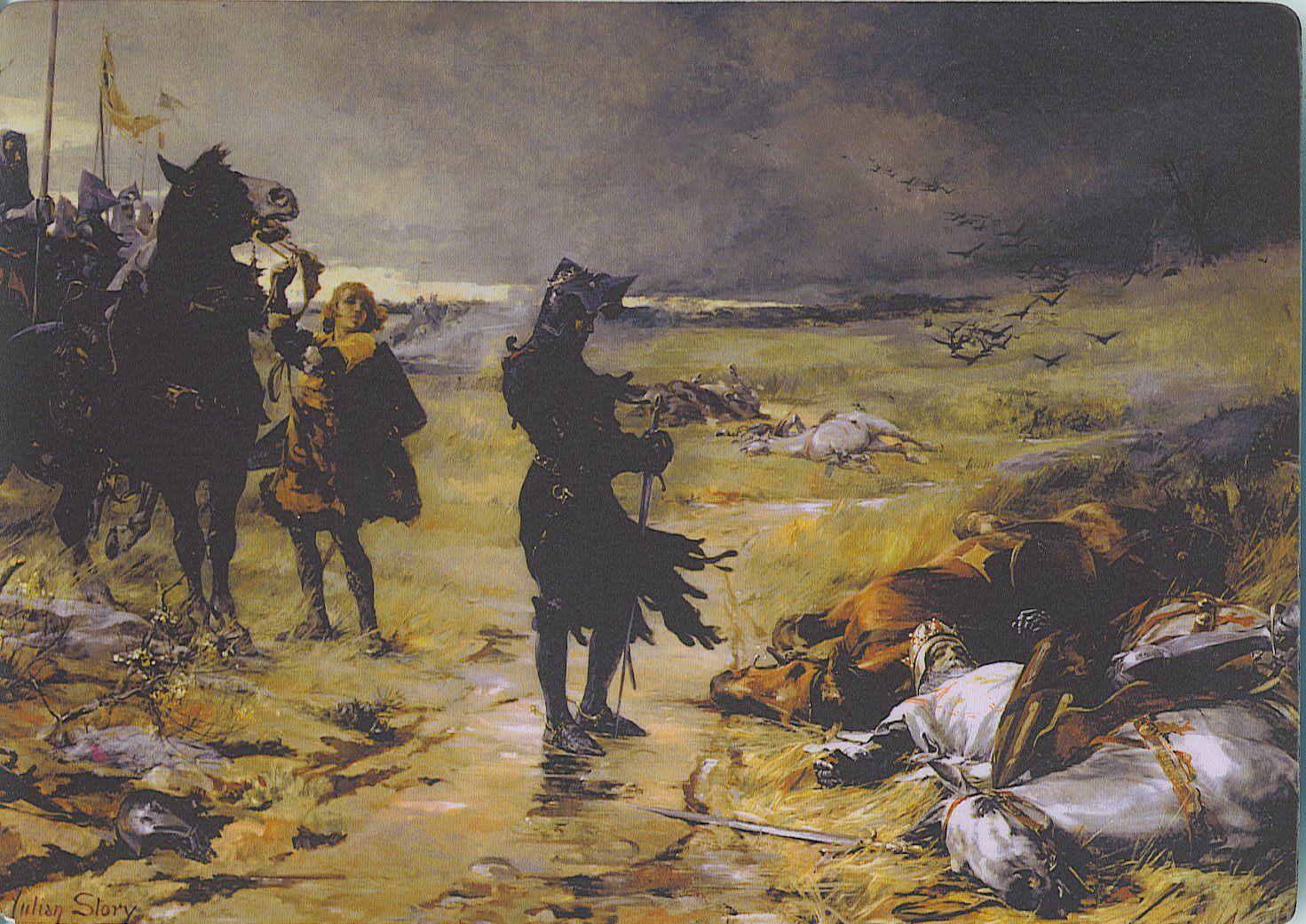|
Richard Fitz-Simon
Sir Richard Fitz-Simon KG, of Pensthorpe, Bawsey, and Glosthorpe (in Bawsey), Norfolk, Letheringham, Suffolk, etc. was a founder member and 15th Knight of the Order of the Garter in 1348. Career Richard Fitz-Simon is recorded as having taken part in a tournament at Dunstable in 1334. He later served in Flanders. In 1344, he was part of a diplomatic mission to Castile and in 1345-6 he served with Henry of Grosmont in Aquitaine. In 1346, he served as the standard bearer of Edward, the Black Prince at the Battle of Crecy, where he saved the prince's life at the peak of the fighting. In 1348, he was appointed to the Order of the Garter. Marriage He married before Hilary term 1345 (date of lawsuit) Ada Botetourt, widow of Sir John de Saint Philibert. They had no issue. Richard's wife Ada Botetourt was the daughter of Sir John Botetourt, 1st Lord Botetourt, by his wife, Maud, daughter of Sir Thomas Fitz Otes and great-granddaughter of William Longespée, 3rd Earl of Salisbury ... [...More Info...] [...Related Items...] OR: [Wikipedia] [Google] [Baidu] |
Fitzsimon 1430
Fitzsimon is a surname. Notable people with the surname include: * Henry Fitzsimon (1566–1643), Irish Jesuit controversialist * Walter Fitzsimon (died 1511), Archbishop of Dublin and Lord Chancellor of Ireland See also * Fitzsimons {{surname Patronymic surnames Surnames from given names ... [...More Info...] [...Related Items...] OR: [Wikipedia] [Google] [Baidu] |
Order Of The Garter
The Most Noble Order of the Garter is an order of chivalry founded by Edward III of England in 1348. The most senior order of knighthood in the Orders, decorations, and medals of the United Kingdom, British honours system, it is outranked in United Kingdom order of precedence, precedence only by the Award, decorations of the Victoria Cross and the George Cross. The Order of the Garter is dedicated to the image and Coat of arms, arms of Saint George, England's patron saint. Appointments are at the Monarchy of the United Kingdom, Sovereign's sole discretion, typically made in recognition of national contribution, service to the Crown, or for distinguished personal service to the Monarch. Membership of the order is limited to the sovereign, the Prince of Wales, and no more than 24 living members, or Companions. The order also includes Supernumerary Knights and Ladies (e.g., members of the British royal family and foreign monarchs). The order's emblem is a garter (stockings), gar ... [...More Info...] [...Related Items...] OR: [Wikipedia] [Google] [Baidu] |
Dunstable
Dunstable ( ) is a market town and civil parish in Bedfordshire, England, east of the Chiltern Hills, north of London. There are several steep chalk escarpments, most noticeable when approaching Dunstable from the north. Dunstable is the fourth largest town in Bedfordshire and along with Houghton Regis forms the westernmost part of the Luton/Dunstable urban area. Etymology In Roman times there was a minor settlement called Durocobrivis in the area now occupied by modern-day Dunstable. There was a general assumption that the nominative form of the name had been Durocobrivae, so that is what appears on the map of 1944 illustrated below. But current thinking is that the form ''Durocobrivis'', which occurs in the Antonine Itinerary, is a fossilised locative that was used all the time and Ordnance Survey now uses this form. There are several theories concerning its modern name: *Legend tells that the lawlessness of the time was personified in a thief called Dun. Wishing to c ... [...More Info...] [...Related Items...] OR: [Wikipedia] [Google] [Baidu] |
Flanders
Flanders ( or ; ) is the Dutch language, Dutch-speaking northern portion of Belgium and one of the communities, regions and language areas of Belgium. However, there are several overlapping definitions, including ones related to culture, language, politics, and history, and sometimes involving neighbouring countries. The demonym associated with Flanders is Flemings, Fleming, while the corresponding adjective is Flemish people, Flemish, which can also refer to the collective of Dutch dialects spoken in that area, or more generally the Belgian variant of Standard Dutch. Most Flemings live within the Flemish Region, which is a federal state within Belgium with its own elected government. However, like Belgium itself, the official capital of Flanders is the City of Brussels, which lies within the Brussels, Brussels-Capital Region, not the Flemish Region, and the majority of residents there are French speaking. The powers of the Flemish Government in Brussels are limited mainly ... [...More Info...] [...Related Items...] OR: [Wikipedia] [Google] [Baidu] |
Henry Of Grosmont
Henry of Grosmont, Duke of Lancaster (– 23 March 1361) was an English statesman, diplomat, soldier, and Christian writer. The owner of Bolingbroke Castle in Lincolnshire, Grosmont was a member of the House of Plantagenet, which was ruling over England at that time. He was the wealthiest and most powerful peer of the realm. The son and heir of Henry, 3rd Earl of Lancaster, and Maud Chaworth, Grosmont became one of King Edward III's most trusted captains in the early phases of the Hundred Years' War and distinguished himself with victory in the Battle of Auberoche. He was a founding member and the second knight of the Order of the Garter in 1348, and in 1351 was created Duke of Lancaster. An intelligent and reflective man, Grosmont taught himself to write and was the author of the book ''Livre de Seyntz Medicines'', a highly personal devotional treatise. He is remembered as one of the founders and early patrons of Corpus Christi College, Cambridge, which was established by ... [...More Info...] [...Related Items...] OR: [Wikipedia] [Google] [Baidu] |
Aquitaine
Aquitaine (, ; ; ; ; Poitevin-Saintongeais: ''Aguiéne''), archaic Guyenne or Guienne (), is a historical region of southwestern France and a former Regions of France, administrative region. Since 1 January 2016 it has been part of the administrative region of Nouvelle-Aquitaine. It is situated in the southwest corner of metropolitan France, along the Atlantic Ocean and the Pyrenees mountain range on the border with Spain; for most of its Recorded history, written history Bordeaux has been a vital port and administrative centre. It is composed of the five Departments of France, departments of Dordogne, Lot-et-Garonne, Pyrénées-Atlantiques, Landes (department), Landes and Gironde. Gallia Aquitania was established by the Romans in ancient times and in the Middle Ages, Duchy of Aquitaine, Aquitaine was a kingdom and a duchy, whose boundaries fluctuated considerably. History Ancient history There are traces of human settlement by prehistoric peoples, especially in the Périgord, ... [...More Info...] [...Related Items...] OR: [Wikipedia] [Google] [Baidu] |
Edward, The Black Prince
Edward of Woodstock (15 June 1330 – 8 June 1376), known as the Black Prince, was the eldest son and heir apparent of King Edward III of England. He died before his father and so his son, Richard II of England, Richard II, succession to the British throne, succeeded to the throne instead. Edward nevertheless earned distinction as one of the most successful English commanders during the Hundred Years' War, being regarded by his English contemporaries as a model of chivalry and one of the greatest knights of his age. Edward was made Duke of Cornwall, the first English dukedom, in 1337. He was guardian of the kingdom in his father's absence in 1338, 1340, and 1342. He was created Prince of Wales in 1343 and knighted by his father at Saint-Vaast-la-Hougue, La Hougue in 1346. In 1346, Prince Edward commanded the vanguard at the Battle of Crécy, his father intentionally leaving him to win the battle. He took part in Edward III's Battle of Calais, 1349 Calais expedition. In 1355, he ... [...More Info...] [...Related Items...] OR: [Wikipedia] [Google] [Baidu] |
Battle Of Crecy
A battle is an occurrence of combat in warfare between opposing military units of any number or size. A war usually consists of multiple battles. In general, a battle is a military engagement that is well defined in duration, area, and force commitment. An engagement with only limited commitment between the forces and without decisive results is sometimes called a skirmish. The word "battle" can also be used infrequently to refer to an entire operational campaign, although this usage greatly diverges from its conventional or customary meaning. Generally, the word "battle" is used for such campaigns if referring to a protracted combat encounter in which either one or both of the combatants had the same methods, resources, and strategic objectives throughout the encounter. Some prominent examples of this would be the Battle of the Atlantic, Battle of Britain, and the Battle of France, all in World War II. Wars and military campaigns are guided by military strategy, whereas ba ... [...More Info...] [...Related Items...] OR: [Wikipedia] [Google] [Baidu] |
William Longespée, 3rd Earl Of Salisbury
William Longespée, 3rd Earl of Salisbury (In or before 11677 March 1226) ("Long Sword", Latinised to ''de Longa Spatha'') was an Anglo-Norman nobleman, primarily remembered for his command of the English forces at the Battle of Damme and for remaining loyal to his half-brother, King John, until shortly before John's death. His nickname "Longespée" is generally taken as a reference to his great physical height and the oversized weapons that he used. Early life William was an illegitimate son of Henry II, King of England. His mother was unknown for many years until the discovery of a charter William made that mentions "''Comitissa Ida, mater mea''" (Countess Ida, my mother). This referred to Ida de Tosny, a member of the prominent Tosny (or Toesny) family, who had married Roger Bigod, 2nd Earl of Norfolk in 1181. In 1188, William was recognized as son of King Henry II and received the honour of Appleby, Lincolnshire. Eight years later, his half brother King Richard I mar ... [...More Info...] [...Related Items...] OR: [Wikipedia] [Google] [Baidu] |
Henry II Of England
Henry II () was King of England The monarchy of the United Kingdom, commonly referred to as the British monarchy, is the form of government used by the United Kingdom by which a hereditary monarch reigns as the head of state, with their powers Constitutional monarchy, regula ... from 1154 until his death in 1189. During his reign he controlled Kingdom of England, England, substantial parts of Wales in the High Middle Ages, Wales and Lordship of Ireland, Ireland, and much of Kingdom of France, France (including Duchy of Normandy, Normandy, County of Anjou, Anjou, and Duchy of Aquitaine, Aquitaine), an area that altogether was later called the Angevin Empire, and also held power over Kingdom of Scotland, Scotland and the Duchy of Brittany. Henry was the eldest son of Geoffrey Plantagenet, Count of Anjou, and Empress Matilda, Matilda, daughter of Henry I of England. By the age of fourteen, he became politically and militarily involved in The Anarchy, his mother's efforts ... [...More Info...] [...Related Items...] OR: [Wikipedia] [Google] [Baidu] |
Elias Ashmole
Elias Ashmole (23 May 1617 – 18 May 1692) was an English antiquary, politician, officer of arms, astrologer, freemason and student of alchemy. Ashmole supported the royalist side during the English Civil War, and at the restoration of Charles II he was rewarded with several lucrative offices. Ashmole was an antiquary with a strong Baconian leaning towards the study of nature. His library reflected his intellectual outlook, including works on English history, law, numismatics, chorography, alchemy, astrology, astronomy and botany. Although he was one of the founding Fellows of the Royal Society, a key institution in the development of experimental science, his interests were antiquarian and mystical as well as scientific. He was an early freemason, although the extent of his involvement and commitment is unclear. Throughout his life he was an avid collector of curiosities and other artefacts. Many of these he acquired from the traveller, botanist and collector John Tradesca ... [...More Info...] [...Related Items...] OR: [Wikipedia] [Google] [Baidu] |






